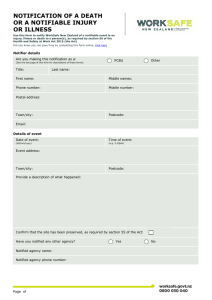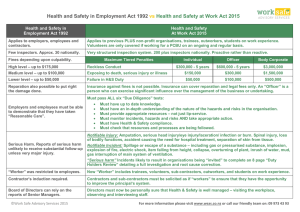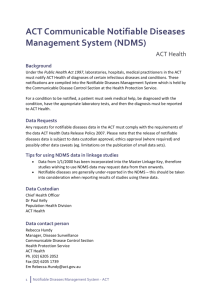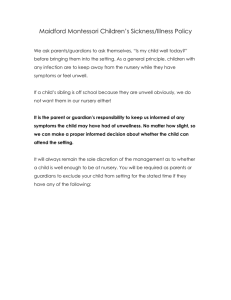What events need to be notified?
advertisement
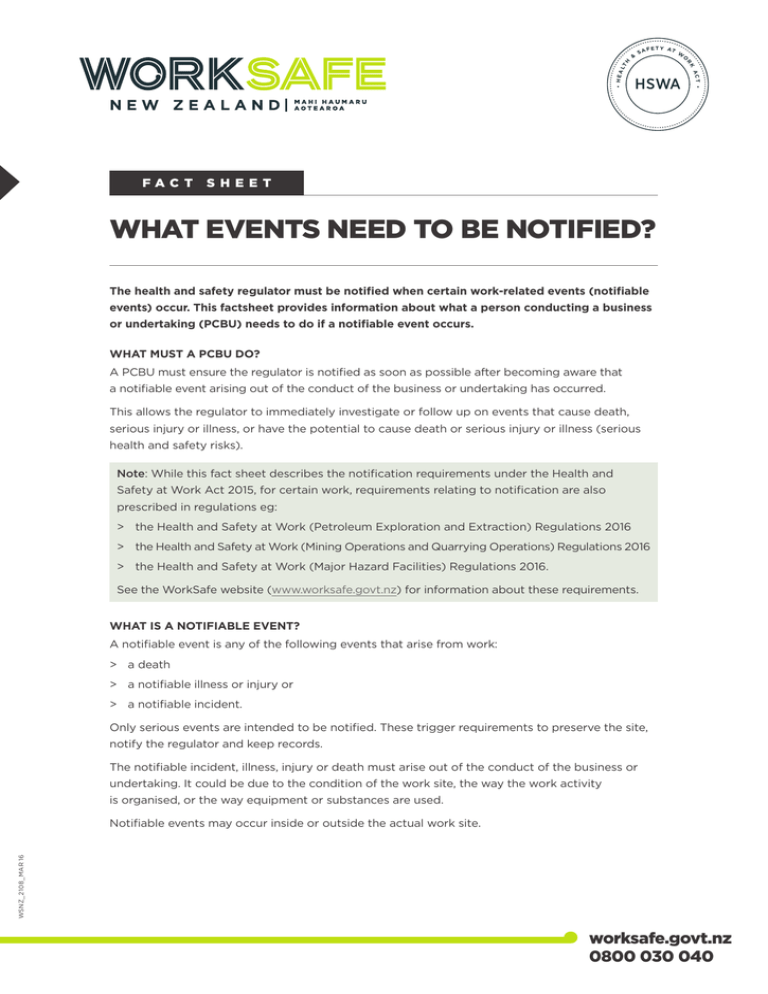
SA F E T Y AT W • LT HSWA AC T • HEA K FAC T O R H & S H E E T WHAT EVENTS NEED TO BE NOTIFIED? The health and safety regulator must be notified when certain work-related events (notifiable events) occur. This factsheet provides information about what a person conducting a business or undertaking (PCBU) needs to do if a notifiable event occurs. WHAT MUST A PCBU DO? A PCBU must ensure the regulator is notified as soon as possible after becoming aware that a notifiable event arising out of the conduct of the business or undertaking has occurred. This allows the regulator to immediately investigate or follow up on events that cause death, serious injury or illness, or have the potential to cause death or serious injury or illness (serious health and safety risks). Note: While this fact sheet describes the notification requirements under the Health and Safety at Work Act 2015, for certain work, requirements relating to notification are also prescribed in regulations eg: >> the Health and Safety at Work (Petroleum Exploration and Extraction) Regulations 2016 >> the Health and Safety at Work (Mining Operations and Quarrying Operations) Regulations 2016 >> the Health and Safety at Work (Major Hazard Facilities) Regulations 2016. See the WorkSafe website (www.worksafe.govt.nz) for information about these requirements. WHAT IS A NOTIFIABLE EVENT? A notifiable event is any of the following events that arise from work: >> a death >> a notifiable illness or injury or >> a notifiable incident. Only serious events are intended to be notified. These trigger requirements to preserve the site, notify the regulator and keep records. The notifiable incident, illness, injury or death must arise out of the conduct of the business or undertaking. It could be due to the condition of the work site, the way the work activity is organised, or the way equipment or substances are used. WSNZ_2108_Mar 16 Notifiable events may occur inside or outside the actual work site. worksafe.govt.nz 0800 030 040 Deaths, injuries or illness that are unrelated to work are not notifiable events eg: >> a diabetic worker slipping into a coma at work >> a worker being injured driving to work in his or her private car when the driving is not done as part of their work >> injuries to patients or rest home residents that are triggered by a medical reason (eg injuries from a fall caused by a stroke) >> a worker fainting from a non-work related cause. WHAT IS A NOTIFIABLE ILLNESS OR INJURY? These are specified serious work-related illnesses or injuries. All injuries or illnesses which require a person to be admitted to hospital for immediate treatment are notifiable. The other types of injuries and illnesses that also require notification are set out in the following table (Table 1). TRIGGER EXAMPLES An injury or illness that requires (or would usually require) the person to be admitted to hospital for immediate treatment ‘Admitted to a hospital’ means being admitted to hospital as an inpatient for any length of time – it doesn’t include being taken to the hospital for out-patient treatment by a hospital’s A&E department, or for corrective surgery at a later time, such as straightening a broken nose. The amputation of any part of the body that requires immediate treatment (other than first aid) Amputation of: A serious head injury that requires immediate treatment (other than first aid) >> fractured skull >> a limb (eg an arm or leg) >> other parts of the body (eg hand, foot, finger, toe, nose, ear). >> a head injury that results in losing consciousness >> blood clot or bleeding in the brain >> damage to the skull that may affect organ or facial function >> a head injury that results in temporary or permanent memory loss. A serious eye injury that requires immediate treatment (other than first aid) >> injury that results in, or is likely to result in, the loss of an eye or vision (total or partial) >> injury caused by an object entering the eye (eg metal fragment, wood chip) >> contact with any substance that could cause serious eye damage. Does not include: >> exposure to a substance or object that only causes discomfort to the eye. A serious burn that requires immediate treatment (other than first aid) A burn that needs intensive or critical care such as a compression garment or skin graft. Does not include: >> a burn treatable by washing the wound and applying a dressing. A spinal injury that requires immediate treatment (other than first aid) >> injury to the cervical, thoracic, lumbar or sacral vertebrae, including discs and spinal cord. Does not include: >> back strain or bruising. TRIGGER EXAMPLES Loss of a bodily function that requires immediate treatment (other than first aid) (eg through electric shock or acute reaction to a substance used at work) Loss of: >> consciousness (includes fainting due to a work-related cause eg from exposure to a harmful substance or heat) >> speech >> movement of a limb (eg long bone fractures) >> function of an internal organ >> senses (eg smell, touch, taste, sight or hearing). Does not include: >> fainting not due to a work-related cause >> a sprain, strain or fracture that does not require hospitalisation (except for skull and spinal fractures). Serious lacerations that require immediate treatment (other than first aid) >> serious deep cuts that cause muscle, tendon, nerve or blood vessel damage, or permanent impairment >> tears to flesh or tissue – this may include stitching or other treatment to prevent loss of blood or bodily function and/or the wound getting infected. Does not include: >> superficial cuts treatable by cleaning the wound and applying a dressing >> lacerations that only require a few stitches from a GP’s office >> minor tears to flesh or tissue. Skin separating from an underlying tissue (degloving or scalping) that requires immediate treatment (other than first aid) >> skin separating from underlying tissue where the tendons, bones, or muscles are exposed. Contracting a serious infection (including occupational zoonoses) to which the carrying out of work is a significant contributing factor including any infection due to carrying out work: >> diseases caught from animals (eg leptospirosis) or E. coli infections >> with micro-organisms >> that involves providing treatment or care to a person >> that involves contact with human blood or bodily substances >> that involves handling or contact with animals, their hides, skins, wool or hair, animal carcasses or waste products or >> that involves handling or contact with fish or marine mammals. >> Legionnaire’s Disease caught from working with soil, compost or potting mix. TRIGGER EXAMPLES An injury or illness that requires (or would usually require) medical treatment within 48 hours of exposure to a substance (a natural or artificial substance in any form eg solid, liquid, gas or vapour) Burns from skin exposure or inhalation of toxic chemicals that require medical treatment. An illness or injury declared in regulations to be a notifiable injury or illness Any illness or injury listed in Schedule 5 of the Health and Safety At Work (Mining Operations and Quarrying Operations) Regulations 2016. In this table: >> ‘Medical treatment’ is considered to be treatment by a registered medical practitioner (eg a doctor). >> ‘Immediate treatment’ is urgent treatment, and includes treatment by a registered medical practitioner, registered nurse or paramedic. >> If immediate treatment is not readily available (eg because the injury happened at a remote site), the notification must still be made. Table 1: Notifiable injuries and illnesses1 WHAT IS A NOTIFIABLE INCIDENT? A notifiable incident is an unplanned or uncontrolled incident in relation to a workplace that exposes the health and safety of workers or others to a serious risk arising from immediate or imminent exposure to: >> a substance escaping, spilling, or leaking >> an implosion, explosion or fire >> gas or steam escaping >> a pressurised substance escaping >> electric shock (from anything that could cause a lethal shock, for example it would not include shocks due to static electricity, from extra low voltage equipment or from defibrillators used for medical reasons) >> the fall or release from height of any plant, substance, or thing >> damage to or collapse, overturning, failing or malfunctioning of any plant that is required to be authorised for use under regulations >> the collapse or partial collapse of a structure >> the collapse or failure of an excavation or any shoring supporting an excavation >> the inrush of water, mud, or gas in workings in an underground excavation or tunnel >> the interruption of the main system of ventilation in an underground excavation or tunnel >> a collision between two vessels, a vessel capsize, or the inrush of water into a vessel >> any other incident declared in regulation to be a notifiable incident, for example those listed in: –– regulation 6 of the Health and Safety At Work (Asbestos) Regulations 2016 1 Based on the SafeWork Australian document Incident Notification Information Sheet November 2015. –– Schedule 5 of the Health and Safety At Work (Mining Operations and Quarrying Operations) Regulations 2016 –– regulation 33 of the Health and Safety At Work (Major Hazard Facilities) Regulations 2016 –– regulation 70 of the Health and Safety at Work (Petroleum Exploration and Extraction) Regulations 2016. Notifiable incidents do not include controlled activities that form part of the business or undertaking (eg the controlled release of water from a dam). A notifiable incident is where someone’s health or safety is seriously endangered or threatened. People may be put at serious risk even if they were some distance from the incident (eg from a gas leak). A notifiable incident also covers the incidents specified above which may have only resulted in minor (non-notifiable) injuries but had the potential to cause serious injury, illness or death. WHAT MUST A PCBU DO IF A NOTIFIABLE EVENT OCCURS? STEP 1: A PCBU MUST PRESERVE THE SITE WHERE THE NOTIFIABLE EVENT OCCURS The PCBU who manages or controls the workplace where the notifiable event occurs must preserve the site The PCBU who manages or controls the workplace must take all reasonable steps to ensure the site of a notifiable event is not disturbed until authorised by an Inspector (ie an Inspector gives permission for normal work to resume at the site of a notifiable event)2. What are the exceptions to this requirement? Exceptions are if the disturbance is: >> to help an injured person >> to remove a deceased person >> essential to make the site safe or to minimise the risks of a further notifiable event >> by or under direction of a constable (police officer) >> permitted by the regulator or an Inspector. Regulations can also exclude particular sites from the requirement to preserve sites in particular circumstances (note: there are none at present). What should the PCBU do? To ensure that the site is not disturbed: >> the work set-up should not be changed >> any plant, substances or other things involved in the event should stay where they are >> work that could interfere with the scene of the event should stop >> no alterations should be made to the plant, vehicles, or structures involved. Can work continue? Work can continue in other parts of the workplace. 2 This does not apply if the event is being investigated under the Armed Forces Discipline Act 1971 or the Transport Accident Investigation Commission Act 1990. STEP 2: A PCBU MUST NOTIFY THE REGULATOR AS SOON AS POSSIBLE When must notification occur? A PCBU must ensure the regulator is notified as soon as possible after it becomes aware of a notifiable event arising from the conduct of the business or undertaking. This notification must be done even if emergency services attend. Only one notification is required for each notifiable event. If there are multiple PCBUs, who is responsible for notifying? If multiple PCBUs are involved in the work, one PCBU should be nominated to notify the regulator. However, all PCBUs are responsible for ensuring a notification is made. Who do PCBUs notify? Depending upon the work, the ‘regulator’ is either WorkSafe New Zealand (WorkSafe) or a designated agency. In most cases, it will be WorkSafe. See the WorkSafe website (www.worksafe.govt.nz) for information about who the designated agencies are, what work they cover and how to contact them. How do PCBUs notify? The regulator must be notified by the fastest means possible given the circumstances. The person giving the notification must provide details about the notifiable event as requested by the regulator. For phone notifications, the regulator will send an acknowledgement that the notification has been received. REGULATOR CONTACT BY WorkSafe By telephone ring 0800 030 040 By email healthsafety.notification@worksafe.govt.nz Forms and information about alternative ways to notify are available from the WorkSafe website www.worksafe.govt.nz Go to the WorkSafe website (www.worksafe.govt.nz) for what information about the notifiable event needs to be provided. STEP 3: A PCBU MUST KEEP RECORDS OF NOTIFIABLE EVENTS The PCBU must keep records of notifiable events for at least five years from the date the regulator was notified about the event. WHAT WILL HAPPEN AFTER A NOTIFICATION IS MADE? All notifications to WorkSafe are referred to WorkSafe’s Response team. Each notification is looked at to decide what WorkSafe will do. WorkSafe has a range of options available, including conducting an investigation or inviting the duty-holder to participate in an assisted review of their health and safety system. If no action is required, WorkSafe will confirm this. DO PCBUs NEED TO INVESTIGATE NOTIFIABLE EVENTS? Although the Health and Safety at Work Act 2015 does not explicitly state that PCBUs must investigate notifiable events3, investigations of notifiable events form part of good practice to identify and manage work risk. After notifiable events PCBUs should consider: >> investigating what happened >> working out what can be changed to prevent it happening again >> making those changes. PUBLISHED: March 2016. CURRENT UNTIL REVIEW IN 2018. 3 Note: some health and safety regulations do require notifiable events to be investigated (eg the Health and Safety at Work (Mining Operations and Quarrying Operations) Regulations 2016). worksafe.govt.nz 0800 030 040
